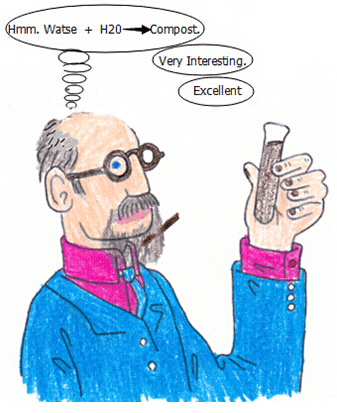
In this section we take a close look at what you have and what your plants need and expect from you.
Surprisingly plants require very little. If we look at a typical mandarin tree in good condition it will produce 90 to 100 kilograms of organic mandarins every year. Inorganic trees produce less at around 60 to 90 kilograms when fed with synthetic fertilizers with inferior flavour. (Figures taken from our orchard and neighbouring orchards at Nana Glen. 1996 to 2006)
Fruit production was more even over a decade on the organic orchard where as on those orchards using chemicals production was more volatile between good seasons and poor seasons. The trees produced marginally more fruit in good seasons when prices were suppressed and lower volumes when prices were at a premium.
Chemical fertilizers cause stress to plants and give the plants a rush followed by withdrawal periods disturbing the microbes in the soil and upsetting any equilibrium that are endeavouring to get established. Organic soils have a balance in place for your plants supplying their needs as they need them. Organic soils can replenish the balance as the plants use the different element. The use of synthetic chemicals drives forces in erratic cycles controlled by people who do not fully understand the integral reactions between micronutrients, macronutrients, microbiology, and macro biology taking place within the soil.
Organic fertilizers help retain moisture in the soil where as those laced with synthetic chemicals dry out quicker causing cracking or greater imbalances of what is available to the plants. Carbon is especially proficient at this while chemical induced soils are devoid or become depleted in carbon very quickly. High levels of carbon resulted in us not having to water our Orchard for the last three years from 2005 to 2007 yet production kept increasing.
The only 100mm sure method of knowing what is wrong is tissue analysis which is equivalent to a blood test in animals and soil chemical tests. I have discussed this at the bottom of the page.
Pages 2 to 35 discuss the physical signs of chemical problems within plants. These can be and are usually compounded by more than one problem being exhibited at time. It is rare to have a single chemical problem in the soil. The best method of control is compost and plenty of it. High carbon soils are usually well balanced soils.
Acid Neutral Alkaline
What is soil pH? The soil pH maybe little letters but can spell big problems or is it? The soil pH is a measure of how acid or how alkaline your soil is. It is measured on a scale from 1 to 13 and is logarithmic. This means each division is 10 times bigger or smaller than the adjacent division. A 6pH soil is 10 times more acidic than a 7pH and 5pH is 10 times more than 6pH or 100 times more acidic than 7pH.
Acid soils measure 1pH to 6.9pH. Neutral stands alone with a pH of 7 while alkaline soils measure 7.1pH to 13pH.
So what is the best pH?
This question depends on the plants you wish to grow. The pH is so important for healthy plants we have allocated the plants a pH measure in our texts based on the plants natural variations in the wild. Somewhere between these parameters the ideal is met but these will vary on the actual chemicals and other salts available to the plants in the soils.
Pure water has a pH of value of 7 but as it dissolves minerals and nutrients the water becomes acid or alkaline. Water that is able to dissolve more calcium, phosphorous or magnesium; the alkaloid minerals, becomes alkaline. Conversely water that is able to dissolve more iron, sulphur or manganese the acid minerals, becomes acidic.
You will notice that most Australian native plants have developed a liking for soils which range between a pH of 5.5 and 6.5. This indicates they prefer acid soils. While nutrients like phosphorous, magnesium and calcium may be available in the soil they are not available to most plants. Most Australian plants will happily grow without these minerals or be happy to have them in low amounts. Conversely the opposite is true these same plants are better able to utilize and take up or absorb minerals that are more readily available in acid soils like iron, manganese and sulphur.
It doesn’t need saying but I will reiterate it anyway “Composts contain all the elements needed for healthy plant growth in a form that is available to the plants and is proportionally balanced which are best suited for your plants health and beauty.”
COMPOST
Compost is the single most important additive that nature can supply for growing healthy plants.
* Good composts will have good moisture retention qualities when added to the soil.
* Good compost creates good aeration when added to the soil.
* Good compost will have a balance of minerals and nutrients.
* Good compost will have a good buffering affect on the soil.
* Good compost will have a pH measurement of 6.7ph to 7.1pH and will aid the take up of nutrients in the soil.
The pH will vary on what organic materials you use in the blending to make the compost.
The ideal compost will have a Carbon to Nitrogen ratio of 27:1–30:1.
When making compost we aim for the ideal to get things motoring along at top speed without any rancid odors. The ideal compost will create temperatures of 60 to 70 degrees centigrade.
Any vegetable or animal material is fine.
Nitrogen speeds the process of fermentation and decay, kills harmful pathogens but can produce bad odours.
Carbon slows the process of fermentation and decay down, won’t kill harmful pathogens and it does not have an odor.
That is why nature performs best with a ratio of 27:1 to 30:1 ratio.
Be aware of what you place in the compost even simple things like old penicillin tablets or urine if the person or animal has been on antibiotics can kill the whole process off very quickly. Substances like old carpets which have chemicals spilt on them can concentrate heavy metals in your garden.
Common materials that can be used around the house can be placed into 4 groups. Those that are very high in nitrogen, high in nitrogen, high in carbon and very high in carbon are listed below.
You need a mix that is ideally 30:1. If you use 50 kilograms of sawdust with a rating of 300:1 and you have some good blood and bone at 5:1.
First divide the sawdust at 300 by 30 which equals 10kg of nitrogen is required.
Divide the blood and bone at 5 by 30 which equals 0.2kg.
Now multiply them both by a figure to round the lower number out. In this case it is 5.
10 by 5 equals 50. 0.2 by 5 equals 1. This means you need 1 kilogram of the blood and bone for every 50 kilograms of hardwood sawdust.
Most the items listed below are freely available in Australia though it may depend on where you live, the time of year and local knowledge or who you know to gain access to bulk quantities.
Very high nitrogen materials have a Carbon Nitrogen ratio under 10:1. You should add one or more of these materials to accelerate the process.
Urine 0.5-1
Crustacean waste 3
Slaughter house waste 3
Blood meal 3
Fish wastes 4
Duck weed 12-4 (Depends on the origin of the feed and whether they are caged or free range)
Milk products 5
Seed meals (Cotton seed) 6-7
Bone meal 6
Soy trash/meal 6
Activated sewage sludge 5 -7 (The origin is vital as those from industrial areas may be heavilly tainted with heavy metals while those from rural areas may be lower with lower nitrogen ratios)
Dry dog or cat food 6-10
Animal manures poultry & pig 6-10 (Depends on their food supply, the amount and type of bedding used & whether they are caged, penned or free range.)
Seaweed 5-27 (Cold water seaweeds generallyhave a lower ratio at 5-1 compared to warm water mid ocean sea weeds that generally have the higher ratio of 27-1)
High nitrogen materials have a Carbon Nitrogen ratio from 11:1 to 27:1 are considered to be optimal in nitrogen.
- Seaweed 5-27 (Cold water seaweeds generallyhave a lower ratio at 5-1 compared to warm water mid ocean sea weeds that generally have the higher ratio of 27-1)
- Vegetable processing waste 11 -14
- Fresh sheep manure 15
- Food scraps 15
- Digested sewage sludge 16
- Legume hay 15-20
- Coffee grounds & Tea leaves 20
- Hay from legumes like alfalfa and clover 15-20
- Cow and horse manure 15-20 (Depends on their food supply.)
- Lawn clipping 10-25 (Be aware that these may contain pesticides and herbicides which could kill the beneficial bacteria off)
- Fresh green weeds and plant waste 20-25
- Water hyacinth 12-30 (Higher values from environmental wetland management)
- leaves from leguminous trees such as Cassias and Acacias 20-30
High carbon materials have a Carbon Nitrogen ratio between 31:1 and 80:1. They are the drier and lighter in weight by volume. These are important in providing your compost for good aeration.
- Fresh semi green hay from non legume crops 50
- Semi green straw 60-75
- Corn cobs and stalks 75-100
Very high carbon materials have a Carbon Nitrogen ratio over 80:1.
These materials can be useful when dealing with a lot of very high nitrogen wastes or to make up bulk in compost. For example, if sawdust was readily available you would only need small amounts of blood and bone or urine to make a large quantity of compost. Beware though we used a lot of sawdust on our orchard with blood and bone, road kills and milk waste and once it started to activate and cook 600 cubic meters of aged sawdust was quickly reduced to less than 20 cubic meters. In another area sawdust 2 meters in height was laid directly between the trees was reduced to less than 100 millimeters in a matter of a couple of months.
- Corn cobs and stalks 75-100
- Sugar cane baggass 85
- General dry hay 80-120
- Used paper towels, napkins and Kleenex 100
- Rice husks 120
- Newspapers 350-500
- Toilet paper, paper towel and gift wrap rolls 200-350
- shredded cardboard 300-500
- Softwood from pine plantations 300
- Hardwood from Eucalyptus sawdust 400
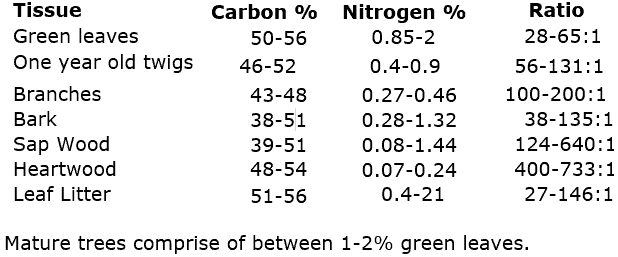
Before we look at the elements in a simple form lets look at the big picture where organic materials are complex living structures.
- Blood and Bone contains N8 P4.5 K 0.5 Ca9 This refers to the product having 8mm nitrogen, 4.5mm Phosphorous, 0.5mm Potasium and 9mm Calcium the remaining 78mm is mainly Carbon Compounds.
- Sugar Cane Mill Mud contains N 0.22-1.7 P 0.22-1.9 K0.03-0.59 S 0.03-0.59 Ca 0.46-3.7 Mg 0.9-0.68.
- Sugar Cane Ash contains N 0.04-0.15 P 0.09-0.41 K 0.05-1.4 S 0.01-0.19 Ca 0.36-1.22 Mg 0.24-0.72
Variations in elemental nutrient levels of some animal manures.
Nutrient content—elemental mm nitrogen (N) mm
Phosphorus (P) mm
Potassium (K) mm
C:N ratio
Manure N P K C:N Ratio
Cow 0.5—2.0 0.1—0.7 0.3—1.5 11:1—30:1
Horse 0.4—0.5 0.1 0.3—0.6 15:1—50:1
Sheep 0.6—3.0 0.1—0.7 0.2—2.6 13:1—26:1
Goat 1.0—1.4 0.2 1.0 11:1—16:1
Pig 0.5—0.6 0.2 0.1—0.3 9:1—24:1
Chicken 1.2—4.0 0.4—1.3 0.4—1.7 6:1—14:1
Broiler litter 1.6—3.9 1.3 1.7 12:1—15:1
20 nutrients required by plants.
Deficiencies Toxicities & Remedies.
The 2 most important minerals are:
Observation is a Powerful Tool. Before we look at this section remember for a moment that “observation is a powerful tool.”
Many symptoms in plants like in people can mean more than one ailment. Often one ailment leads to a secondary problem or a tertiary problem all complicating the diagnosis. The best way to treat an ailment is prevention. After the condition has arisen tissue analysis and soil tests like blood tests are the only certain methods that can evaluate what the problems or ailments are.
Most ailments are caused by humans not nature. The wrong plants in the soil, wrong topography, the wrong climate, the addition of the wrong fertilizers or too much or too little will all complicate things. Even aeration will play an important role in a plants health.
In organic farming and gardening; once the balance has reached the optimum in a struggling natural world, fewer problems are experienced both with disease and mineral health of their plants.
Again I cannot over emphasize the need for good observation and understanding of what is happening in the soil.
Water: Best supplied by rain or dam water. Potable water may cause long term problems with chlorides due to the inclusion of the toxic chemical chlorine and the accumulation of salts.
Water cannot be over emphasized for its importance to plants. Water to plants is the same as what blood is to humans. Plants cannot function without water as humans cannot function without blood.
The seed can only commence the germination process once water comes into the equation. The subsequent processes are nothing short of miraculous.
The transport system is where water dissolves minerals, nutrients and water from the soil and transports them from the roots through the xylem (the arteries in a human) up the stems and branches to the leaves, then back down again through the phloem (The veins in humans) to the roots.
The respiratory system is essential for the exchange of gasses. The plants stomata (pores in our skin)
Once the nutrient enriched water arrives in the leaves photosynthesis can begin. Here in the presence of sunlight chlorophyll, caratenoides and malvidin 3-0-glucoside can start converting water and carbon dioxide into glucose. (CO2 + H2O = C6H12O6) Glucose can then be converted into other sugars like fructose (C6H12O6 but differs structurally to glucose) and sucrose (C6H12O6).
Water is the coolant required by plants to regulate cooling on hot days through evaporation. When excess evaporation takes place over absorption plants wilt. Water is used in the process called extracellular freezing. This is a process where some plants actually release water from within their leaves and place it on the outside of the leaves. The water freezes on the outside. The following morning or when the thaw starts the plants reabsorbs the water through their stomata. (Stomata are like the pores in a human’s skin.) Some plants are able to convert sugars into proteins and oils that restrict the size frozen water crystals can grow or lower the freezing temperature of the solution within the leaves. The smaller the crystals are the colder the conditions a plant can survive under.
The best solution is to grow plants that would normally survive under your local weather conditions.
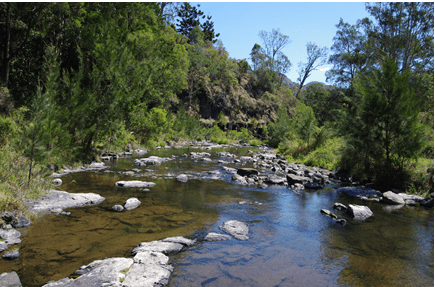
Deficiencies symptoms are: See the section on chlorides and water.
- Wilting.
- Stunted growth or slow growth.
- Short stems
- Prematurely dropping of foliage.
The best solution is to grow plants that would normally survive under your local weather conditions, topography, aspect and soil types.
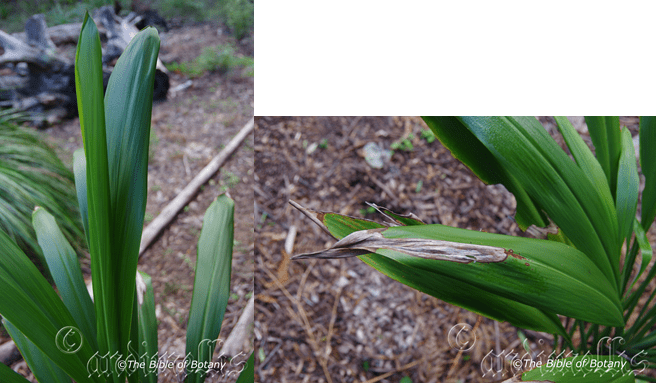
A good soaking with pure water is the best and quickest method to alleviate symptoms.
Secondly select plants that are suitable to the rainfall in your local area.
Toxicity symptoms are: See the section on chlorides and water.
- Wilting that does not respond in the evenings.
- Signs of collar rot.
- Non browning or yellowing of the leaves.
Once these symptoms are noticed it is probably too late. If it is possible remove the source of water.
If the plants are of a size where they can be removed, remove them carefully and transplant them in a better drained area.
The best solution is to grow plants that would normally survive under your local weather conditions, topography, aspect and soil types.
CARBON: Virgin, organic and composted soils are rich in carbon. Farms where synthetic fertilizers have been used for over 10 years usually start showing signs of carbon depletion.
Carbon is the next most important mineral for which without it there is no life as all living things contain carbon. Ideally the carbon ratio to Nitrogen in the soil should be 27:1 to 30:1.
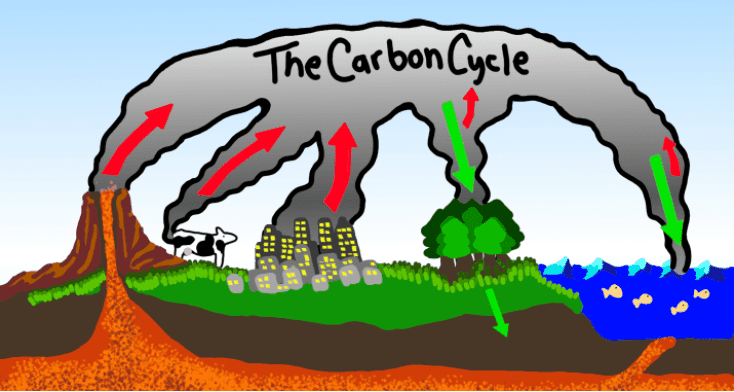
Carbon is a part of all living cells and is the backbone of plants.
It is the bases of all sugar production within a plant and is a vital part in photosynthesis.
When a plant dies and decays all of its collected carbon through the production of sugar is returned to the soil. This is known as sequestered carbon. When plants drop leaves only a part of the carbon is returned to the soil the rest is returned to the atmosphere. It is this balance that has fuelled the earth for millions of years.
Aids in the natural immune system of the plant.
The carbon cycle is the relationship that bonds animals and plants.
Deficiencies symptoms are: Carbon deficiency levels manifest themselves similarly to most nutrient deficiencies but in a more subtle manner.
1. Soils become hard caked and crack more readily – pindin soils.
2. Moisture retention is lowered greatly.
3. Growth is not as vigorous.
4. Smaller plants with a duller appearance.
5. Unwanted weed competition is enhanced.
6. Carbon is what ties all the nutrients together and helps prevent leaching of the macro and micro nutrients.
Replenish carbon stocks in the soil are a slow methodical process using higher carbon composts.
Toxicity symptoms are: There are no carbon toxicity levels as such in the plants. Amazingly though when carbon reaches saturation in a soil, levels will stabilize. Excess carbon placed on the soil before a balance has been reached or the soil has reached saturation can lead to destabilization of the Carbon Nitrogen balance. Optimally the ratio of carbon to Nitrogen is around 27:1 as we saw in composting.
Sudden increases of carbon manifest as
1. Older leaves turn yellow
2. Younger leaves look dull and lifeless.
3. New growth is slow and stunted.
4. Premature wilting may occur despite moisture being present in the soil.
Immediately spray the plants with a solution of fish emulsion in water at double strength.
Apply a good soaking of water enriched with poultry manure or fish emulsion. (Do not use poultry manure on phosphate sensitive plants such as those in the Protaceae family)
Repeat the above steps a week later using normal strength fish emulsion as a foliar spray followed by the soaking, until the vigor of the plants returns to normal.
The big 3 Macro Nutrients are
Nitrogen, Phosphorous and Potassium.
NITROGEN N:
Is a direct result of the overuse of synthetic fertilizers like ammonium nitrate, ammonium sulfate and urea.
Nitrogen is a part of all living cells and is a necessary part of all proteins, enzymes and metabolic processes involved in the synthesis and transfer of energy.
Nitrogen is very important in the manufacturing of chlorophyll, the green pigment of the plant that is responsible for photosynthesis.
Helps plants with rapid growth, increasing seed and fruit production and improving the quality of leaf and forage crops.
Nitrogen often comes from the decomposition of high protein material, green leaves and from the air (legumes fix their Nitrogen from the atmosphere not soil nitrates.)
Mandarins will remove about 0.001mm by weight or 1 kilogram of pure nitrogen per 1,000 kilogram’s of fruit. The leaves in production are about 0.023mm nitrogen or will take up about 23 kilograms of nitrogen per 1,000 kilograms of new leaves produced by the trees. This take up only relates to net take up during active growth. If the centers are at 5 meters by 5 meters you will have 400 trees to the hectare and each tree adds an additional 5 kilograms of leaves in the early years the total net up take of nitrogen is about 4.6 kilograms plus the fruit equates to about 44.6 kilograms of extra nitrogen a year to keep the trees in full production. Amazingly red clover will deliver over 90 kilograms of pure nitrogen a year to the soil. We found that the clover did not die off but regenerated itself and maintained a healthy position between the trees for well over a decade.
What this means is organically you can maintain healthy trees without additional inputs of Nitrogen despite having a high production orchard. The home gardener does not need to maintain their trees at optimum level nor are they removing vast quantities of nitrogen (4.6 kilograms per hectare in full production.) (Arja Nykänen reports that it also found in its tests that there was no leaching of nitrates in organic fields was the case in chemical reliant fields.)
Deficiencies symptoms are:
- The older leaves turn yellow.
- The new growth looks dull and lifeless.
- The new growth is slow and stunted.
- Premature wilting may occur despite moisture being present in the soil.
A good quality Blood and Bone will supply N8 P4.5 K 0.5 Ca9 to the soil. Pure blood and bone is high in protein and is an excellent microbe food, soil stimulator and soil pH balancer.
The quick fix is to spray the leaves with urine. (Human urine analysis is aproximately N9-10 P0 K0.75 NaCl.8 equivalent to most industrial made fertilizer and can be diluted at 1:5 to 1-10 in water for a foliar spray, 1:8 is ideal when used as a soil fertilizer and 1:16 as a soil conditioner.) Short term repaeated applications should be avoided.

Left mild deficiency yellowing of the veins dull appearance. Right general yellowing and dull appearance.
Toxicity symptoms are: Toxicity is associated with too much fertilizer being applied is never a problem with organic growing.
- The leaves become deep green.
- The leaves turn yellow near the apexes.
- The leaves become soft.
- Older leaves are discarded while still green.
- Fruit skins become thicker and puffier.
Apply high carbon mulch close to the trees roots and incorporate it into the soil as much as possible.
Give the plants a really good soaking.

PHOSPHOROUS P: Is a direct result of the overuse of synthetic fertilizers. The problems with using synthetic potashes are the inclusion at different levels of toxic, undesirable heavy metals like fluorides cadmium and uranium. These elements are too expensive to remove from cheap fertilizers, are not required by the plants and are accumulative in the soil.
Like nitrogen, phosphorus is an essential part of the process of photosynthesis.
Involved in the formation of all oils, sugars, starches, etc.
Helps with the transformation of solar energy into chemical energy; proper plant maturation; withstanding stress.
Effects rapid growth.
Encourages blooming and root growth.
Deficiencies symptoms are:
- The leaves turn yellow near the apexes.
- Abnormal slow growth.
- A lack of luster in the leaves of severe deficiencies.
- New growth has a blue green appearance.
- A good quality Blood and Bone is N8 P4.5 K 0.5 Ca9. Pure blood and bone is high in Phosphorus. Other good sources are rock phosphate and crusher dust from black basalt.
Toxicity symptoms are: Are quite common amongst native growers who inadvertently place normal fertilizers containing calcium or phosphorous to near or up hill to members of the Proteaceae, some Fabaceae, Myrtaceae or Rutaceae. Most of theses families can cope with organic native fertilizers applied at normal or half strengths. This also occurs where new estates have been built on recent farm land.
The leaves turn black in patches along the length of the leaf.
Abnormal slow growth.
Leaves curl upwards from the margins.
Pale dull yellowing mottling of the younger leaves.
The yellowing is then concentrated closer to the base of the leaves.
Green network of veins over a dull yellow leaf.
Poor flowering or flowers stunted or reduced in size.
Fruits have thicker skin and hollow centers where the flesh breaks away from the core.
Fruits are more acidic with less juice.
- Apply a foliar spray every month which contains iron chelate and zinc until the plants regain their vigor.
Another method worth trying if things are desperate is to apply 4.5 kilograms of sulfur to 100 square meters to a sandy soil and up to 7 kilograms of sulfur where the soils are heavy clays if the soil tests indicate satisfactory levels are available and the inclusion of sulfer would not be harmful.
Planting of annuals which are less sensitive that can take up the phosphorous so it can be removed. Removing it means harvesting the annuals immediately following the peak of their flowering while the plants are still green.
Lomandra have a higher tolerance to phosphate and the leaves can be harvested regularly to remove phosphorous from one area and transport it to another area in the garden where less sensitive plants are growing or deficiencies occur.
POTASIUM K: Is a direct result of the overuse of synthetic fertilizers like potassium nitrate, potassium sulphate and potassium carbonate. The problems with using synthetic potassium are where moisture content can vary a lot due to drought or flood. The main reason for chloride toxicity is due to the use of these fertilizers when the plants are subjected to dry or drought conditions. The chlorine molecules will form other chlorides within the soil and are easily leached from the soil being water soluble taking with them other micronutrients thus causing nutrient imbalances or at worst micro nutrient or trace element deficiencies.
1. Potassium is absorbed by plants in larger amounts than any other mineral element except nitrogen and, in some cases, calcium.
2. Helps in the building of protein, photosynthesis, fruit quality.
3. It is the plants Vitamin C and is needed to help fight disease.
Is important in the formation of Vitamin A or the red colouring in plants stomata function (Respiratory)
Deficiencies symptoms: is initially a problem in some organic farms and gardens but will be alleviated with the use of good quality blood and bone or with the use of composts.
- Older leaves will drop prematurely.
- Abnormal slow growth.
- Old leaves first yellow off at the margins then go to a dry brown.
A good quality Blood and Bone is N8 P4.5 K 0.5 Ca9. Pure blood and bone is high in Phosphorus. Other good sources are rock phosphate and crusher dust from black basalt.
Animal urine will vary from 0.5mm to 1mm potassium.
Bracken fern and banana peels are two very good sources of potassium.
Toxicity symptoms are:
- Tips of leaves become brown dry and die prematurely.
- Behind the dead section the leaves turn yellow.
- All the leaves veins turn yellow.
- There maybe a bronze sheen in late summer.
This is more of a problem associated with fertigation or high applications of synthetic fertilizers. It is compounded and usually only noticed during hot dry weather when transpiration rates are high to very high.
Organically the problem is seen where phosphate sensitive plants have had a high application of lime or rock phosphate fertilizers.
Plantings made on new subdivisions where the subdivisions were recently being farmed may still have high potassium levels within the soil.
Avoid calcium and phosphate fertilizers near Protaceae family plants like Grevillea and some Rutaceae members.
Give the plants a good soaking in the evening to increase the ground moisture levels.
Most annuals in the Asteraceae family are less sensitive to potassium and can take up the large amounts of potassium so it can be removed. Removing it means harvesting the annuals immediately following the peak of their flowering while the plants are still green.
Lomandra specie have a higher tolerance to potassium and the leaves can be harvested regularly to remove phosphorous from one area and transport it to another area in the garden where less sensitive plants are growing. High potassium levels may induce stronger flowering in Lomandra specie. Harvested leaves would be beneficial beneath citrus trees.
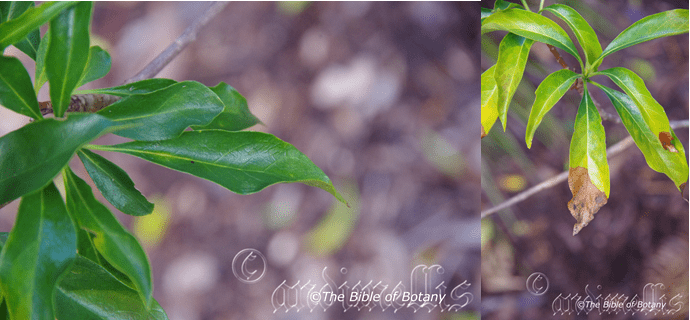
Left Healthy leaf of Hymenosporum flavum. Right accentuated Potasium and or chloride toxicity (salt) on right following at end of severe drought in 2019. Plants fed septic water during drought, which may have had higher levels of salt. The tree recovered quickly following good rain.
The Big Three Primary minerals are Calcium, Magnesium & Sulphur.
CALCIUM Ca: This is an on going problem in more sandy soils particularly where acidic, synthetic fertilizers have been practiced for extended periods.
Calcium is an essential part of plant cell wall structure.
Provides for normal transport and retention of other elements as well as strength in the plant.
It is also thought to counteract the effect of alkali salts and organic acids within a plant.
Aids in the natural immune system of the plant.
Deficiencies symptoms are:
- Yellowing of the leaves particularly nearer the apex and margins.
- Older leaves are affected first.
- Yellowing of the leaves between the veins.
- A distinct green triangle is observed at the base of the leaves.
- Curling of the leaf margins.
- Premature flower drop.
- Fruit goes black at the tips.
- Fruits have a bitter taste.
Calcium deficiencies can be caused by over fertilizing and wet and dry spots in the soil. That is non uniformity of soil moisture.
A good quality Blood and Bone is N8 P4.5 K 0.5 Ca9. Pure blood and bone has a good balance of calcium to the other main nutrients.
Crushed limestone CaO50, dolomite Ca30, gypsum Ca32 or shell grit Ca90 (Crushed Oyster shells) are other good forms of calcium as is bracken fern. When using shell grit ensure it has been adequately washed as many plants are salt sensitive.

Toxicity symptoms are: There is no direct toxicity levels caused to the plants from excessive Calcium however a plethora of other deficiencies will be created amongst the acid nutrients that the plants need such as iron and manganese deficiencies. This is often accentuated amongst acid loving plants like the Protaceae.
- Pale dull yellowing mottling of the younger leaves.
- The yellowing is then concentrated closer to the base of the leaves.
- Green network of veins over a dull yellow leaf.
Calcium toxicity can be caused by sudden rises in the pH of the soil especially where agricultural lime or dolomite has been used. Fertigation can also be another problem area where the balance can be disturbed very easily causing micronutrient deficiencies with some micronutrients and toxicities with others.
Spray the foliage with liquid worm castings.
Apply a foliar spray every month which contains iron chelate until the plants regain their vigor.
Another method worth trying if things are desperate is to apply 4.5 kilograms of sulphur to 100 square meters to a sandy soil and up to 7 kilograms of sulphur where the soils are heavy clays.
MAGNESIUM Mg: Heavily leached coastal soils in Australia are more prone to magnesium deficiencies as are strongly acid sandy soils.
Magnesium is a critical part of the chlorophyll molecule in all green plants and essential for photosynthesis. The chlorophyll platelet in plants is identical to human blood except for the magnesium molecule at the center in chlorophyll in replaced by an iron molecule in animals.
It also helps activate many plant enzymes needed for growth.
Deficiencies symptoms are: Deficiencies are usually due to an accumulation of chemicals which cause rises in the ph.
- Yellowing of the leaves particularly nearer the apex and margins.
- Older leaves are affected first.
- Yellowing of the leaves between the veins.
- A distinct green triangle is observed at the base of the leaves.
- Curling of the leaf margins.
- Premature flower drop.
- Fruit goes black at the tips.
- Fruits have a bitter taste.
Magnesium deficiencies can be caused by over fertilizing of the acid group of fertilizers. Non uniformity of soil moisture and generally a lack of moisture available to the plant in the soil can reduce take up of magnesium.
Crushed dolomite Mg18, shell grit Mg5 (Crushed Oyster shells) or vermiculite Mg8-Mg9 (heat treated mica) are other good forms of calcium as is bracken fern. When using shell grit ensure it has been adequately washed as many plants are salt sensitive.
Good quality volcanic crusher dusts can be a good source of magnesium.
Toxicity symptoms are: Before magnesium levels are recognized in a plant, potassium deficiencies will become normally become apparent.
Older leaves will drop prematurely.
Abnormal slow growth.
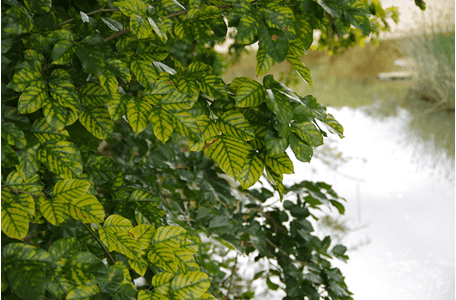
Old leaves first yellow off at the margins then go to a dry brown.
In severe cases older leaves will show a distinct yellowing close to the base which is the only evidence of magnesium toxicity.
Use a foliar spray of animal urine in an attempt to increase the potasium levels within the plant. This will also reduce the competition from other plants if it was supplied to the soil.
Use compost with high quantities of bracken fern in it or use bracken fern mulch beneath the plants
SULPHUR S: Most Australian soils are rich in sulfur containing optimum levels for plants while most farmlands have excellent levels to toxic levels due to past practices.
- Essential for the plants in the production of protein.
- It also helps promote the development enzymes needed for growth.
- Assists in the promotion and development of chlorophyll formation within the leaves.
- Improves root growth and is essential to healthy seed production.
- Helps with vigorous plant growth and resistance to heat and cold.
Deficiencies symptoms are: Sulfur deficiencies can be caused by over fertilizing of the alkaline group of fertilizers, Non uniformity of soil moisture and generally a lack of moisture available to the plant in the soil.
- Pale dull yellowing over the whole lamina.
- The yellowing is over the whole plant uniformly, young leaves and old leaves.
- Reddish or purpling of the veins and petiole.
- Leaves become twisted.
Sulphur deficiencies can be caused by over fertilizing of the alkaline group of fertilizers, Non uniformity of soil moisture and generally a lack of moisture available to the plant in the soil.
Crushed Gypsum has a high percentage of sulphur and can be as high as S40.
Crusher dusts containing iron sulphate (Fools gold) can a good source of natural sulphur and can be as high as S36.
Toxicity symptoms are: Sulphur toxicity is a result of environmental pollution through acid sulphate rains or pollution of water catchment areas by factories and mines. The next common occurrence of the toxicity arises from high doses of sulphate chemical fertilizers like ammonium sulphate, Ammonium polysulphide and thiosulphates and micronutrients and trace elements based on sulphur. Organic practices never have sulphur toxicity problems unless they are environmentally induced.
Leaf size decreases as the plants mature.
Overall growth is stunted.
Leaf margins are yellow.
Leaf margins will eventually become scorched and die.
Extreme toxicity will cause senescence. This is known where premature aging of the plant occurs. It is especially noticeable in annuals and perennials.
Another method worth trying if things are desperate is to apply 4.5 kilograms of dolomite or agricultural lime to 100 square meters to a sandy soil and up to 7 kilograms where the soils are heavy clays.
Here comes Silicon.
SILICON Si:
Silicon is grossly under estimated but is a necessary part of the plants building blocks in cell wall structure and strength. While hydrogen is the most common element in the universe Earth is unique. Silicon is the most common element on Earth making up 27.6mm of the Earths mass compared to oxygen which is the most common element at 46.6mm. Silicon is available to plants in the form of silicon dioxide.(SO4)
Deficiencies symptoms are: There are no deficiency symptoms caused from low levels of Silicon in the ground.
Toxicity symptoms are: There are no toxic symptoms caused from excess Silicon in the ground.
The essential 8
Boron, Copper, Chlorides, Iron, Manganese, Molybdenum & Zinc.
BORON B: Boron is more abundant in soils which have been formed from old sea beds or where water has evaporated from the soils surface over millenniums. These areas are common in central Australia and the Hawsberry sandstones north of Sydney, the Illawarra district south of Sydney and the region between Coffs Harbour and The Pinnacles north of Grafton.
- Is essential in the use of nutrients throughout the plant and regulates the other nutrients.
- Assists in the detoxification when excess nutrients are available.
- Assists in the production of sugars and carbohydrates.
- Is essential in the production of plant proteins.
- Essential for seed and fruit development.
Deficiencies symptoms are:
- Pale dull yellowing over the whole lamina.
- The yellowing is over the whole plant uniformly, young leaves and old leaves.
- Reddish or purpling of the veins and petiole.
- Leaves become twisted.
- Leaves become brittle.
Boron deficiencies can be caused by extended dry periods where inadequate ground water is available to the plants.
Crusher dusts from shale, coal or some metamorphic rocks are high in Boron as are most compost mixes.
Toxicity symptoms are: What is toxic to one specie will be quite acceptable to another specie.
Starts at the apex with tip yellowing and tip browning.
Interveinal blotching is yellow.
Becomes worse on olders leaves as the plants shoot they will concentrate the boron in the older leaves.
Brown spotting occurs in the middle of the yellow and white blotches. The spots are irregular and not uniformally spread over the leaf surface as is the case in manganese toxicity.
Leaf tip or margins become decurved
Sesencences occurs in the older leaves first as toxicity increases.
Keep the moisture level of the soil moist at all times if boron is a problem. If it appears suddenly give the plants a good soaking.
Plant crops like Beetroot, silverbeet or Kale will remove large quantities of boron from the soil so it can be permanently removed or distributed over the property more evenly where more boron tolerant plants are growing. We applied this method using beetroot at Nana Glen when we first started farming when patches throughout the orchard displayed boron toxicity. Within two years the problem was total eliminated and the beetroot was the best we had ever grown.

Growing boron loving plants like Beetroot and Brassicas can help remove excess boron form the soil. A cover crop of rye or wheat followed by removing the slashing from the affected area will also help.
Copper Cu: Copper problems can eventuate from prolonged use of pig manure and slurries from piggeries and the use of sewage cake and slurries. This is more evident if the sewage plants are treating waste from industrial areas. Other problems are associated with prolonged use of herbicides containing copper.
- Important for reproductive growth, leaf size and twig extension.
- Aids in root metabolism and helps in the utilization of proteins.
- Is required in the process of making lignin which is needed for cell wall strength.
- Copper is used in the metabolism of nitrogen
- Aids in the sweetening of fruits
Deficiencies symptoms are: Copper deficiencies can be caused by sudden rises in the pH of the soil.
- Pale dull yellowing over the whole lamina.
- The yellowing is over the whole plant uniformly, young leaves and old leaves.
- Leaves curl and roll inwards.
- Leaves may die back at the tips.
Crusher dusts from black basalts are usually a good source of Copper as are most compost mixes.
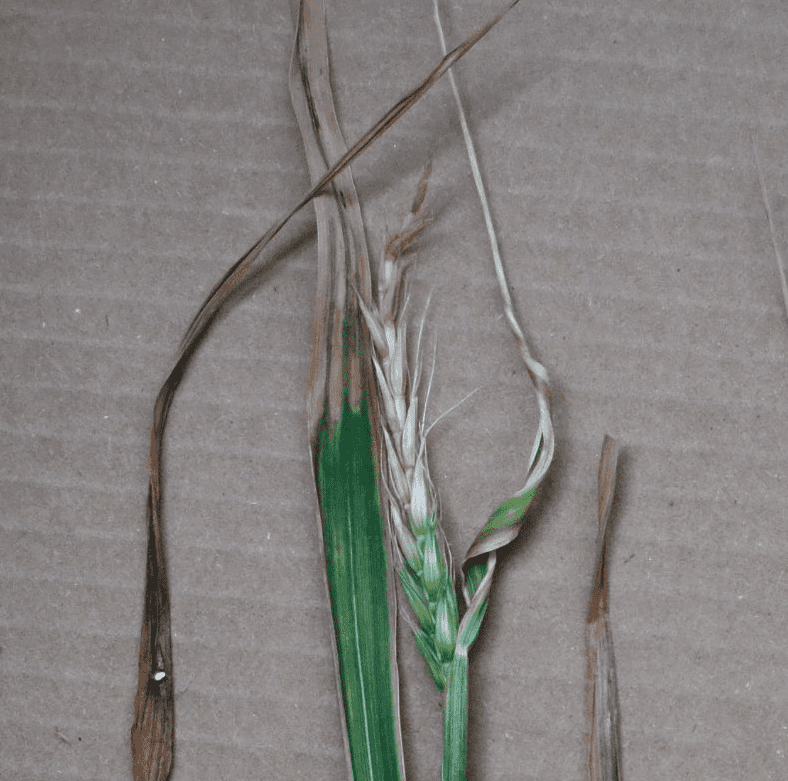
Toxicity symptoms are:
- Interveinal blotching in yellow or white.
- Becomes worse on older leaves as the plants shoot they will concentrate the boron in the older leaves.
- Leaf tip or margins become decurved.
- Sesencence occurs in older leaves first as toxicity increases.
- Root damage may be evident in high toxic situations causing wilting and death.
Applications of blood and bone is beneficial where there are no chances of related problems with phosphorous or nitrogen.
Copious quantities of mulch or compost around the plants are a good long term control as is the limited use of fungicides
CHLORIDE Cl: Choride problems in Australia are always caused by toxicity and never by a deficiency.
Is important in plant metabolism.
Regulates the transportation of water through the stomata.
Regulates the flow of other micronutrients and trace elements throughout the plant.
Is required in osmosis. This is the science of molecules passing through a membrane
in an attempt to equalize the concentration of the two liquids. Known as Osmotic
pressure.
Is required in the process of making lignin which is needed for cell wall strength.
The symptoms: Chloride deficiencies are rarely a problem.
Deficiencies symptoms: are: These are extremely rare in Australian soils.
- Pale dull yellowing at the margin.
- Abnormal shapes of leaves.
Decrease water levels in the soil so that salts and nutrients become more concentrated.
The use of good composts with the addition of fresh unwashed sea weed and fish emulsion will alleviate the problem in the long term. In the mean time the plants can be given a foliar feed of a sea weed extract. To make your own sea weed extract collect sea weed from the foreshore. Wash the seaweed in third of a bucket of water. Save the water. Tear the seaweed into small pieces and place the torn strips into the bucket. If the seaweed is of a type that is thick and leathery bruise it first with a meat mallet before tearing. Allow the mix to sit for three days. Use what you need and repeat the process till althea sea weed is used. 50 kilogram’s of seaweed will make about 10 liters of seaweed extract.
Toxicity symptoms are: Chloride toxicities are real problematic. These are caused from incorrect watering needs and the overuse or long term use of synthetic fertilizers. Dry soils or long periods without rain often create surges in salt or chlorides in plants. Prolonged periods of wet weather may raise salt bearing water tables to within the root zone of plants. Tidal surges during the storm season can cause chloride toxicities as the ware tables subside or water evaporates. Toxicity usually affects large areas and suddenly without notice.
The addition of chlorides can be accumulative over time through the use of synthetic fertilizers or watering indoor plants from town water or bore water supplies.
Water especially bore water may be high in chlorides. Bore water should be monitored regularly at first. 1. at the time of installation. 2. one month after installation 3. Six months after installation 4. If it is suspected or over 200 parts per million test it again at 12 months and finally every two years for all bore water. This is simple to do as all that is need is a clean glass bottle, preferably one that has been washed and well rinsed with rain water. Run the bore for 10 minutes with the closest faucet open. Rinse the bottle thoroughly without touching the inside of the bottle or the faucet with your hands then fill the bottle with the bore water.
Leaves wilt without reason.
Leaves may brown off at the tips and are yellow inside the die off portions slowly returning to a dull blue-green.
Leaves will curl at the margins.
Leaves will curl at the margins.
Older leaves affected will commence dropping as the chloride levels increase.
Any of the above signs.
Plants succumb and die as the weather heats up and the soils dry out.
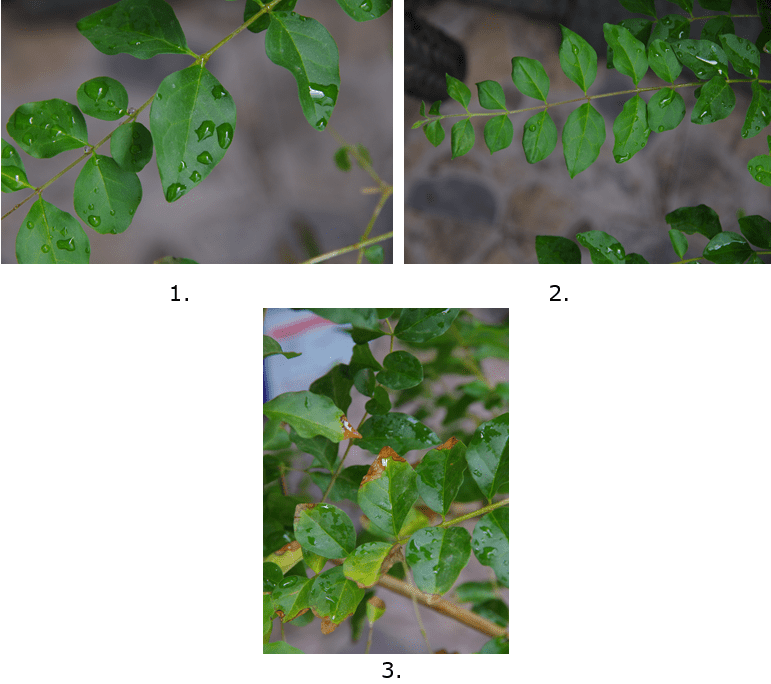
2. Middle stages of Chloride toxicity showing the leaves curling at the margins,
3. Late stages of Chloride toxicity showing burning at apexes and spreading along the margins. The plant was also in a state of dropping its older leaves,
1. Early stages of Chloride toxicity showing the dull paling along the main vein and lateral veins with the typical blue-green instead of the deep sea-green.
2. Middle stages of Chloride toxicity showing the leaves curling at the margins.
3. Late stages of Chloride toxicity showing burning at apexes and spreading along the margins. The plant was also in a state of excess dropping its older leaves.
This is far more difficult to alleviate. If the problem is bought about by rising saline water tables plant shallower rooted plants that are drought tolerant and can cope with extremely saline soils. (See the attached list of plant saline tolerances) Reduce water to the plants to a minimum for survival of the plants.
If the salt has increased for any reason other than a rising water table, increase water levels in the soil so that salts and nutrients become less concentrated.
Irrigation water can be managed by watering at night with micro jets placed above the plants so that any fog can be trapped by the droplets thus reducing the concentration of salts. Night watering also reduces evaporation. We were forced to do this in the early stages of our orchard as we had particularly high levels of salt and boron in the soil and consequently our new dam returned seepage water from an underground stream at marginal levels for citrus. The results from using micro jets at night in foggy weather reduced the salt levels from 400 parts to less than a 150 parts on good evenings the same sprinklers during the day at ground level returned levels of over 600 parts on hot dry days. Also at night water was equivalent to 100mm of rain compared to nearly 30 mm of rain from a day watering. This is a huge difference in acceptable farming practices. This is not rocket science simply efficient, environmentally astute watering.
Good compost will aid in the stabilization of chlorides in the soil assist in lowering water usage by retain more water in the soil. Carbon acts like a sponge below the ground.
Potted plants should be removed from the pot bare rooted and repotted in a clean chloride free mix.
Plants can also be watered thoroughly and leached of the accumulated salts using rain water. This method will also leach other vital nutrients from the pot. Cover the surface with good well composted compost.
IRON Fe: Most Australian soils are high in iron and aluminum. The problem is usually the availability caused by the affects of a high pH. The higher the pH the less iron will be made available to the plants with the iron being tied up in the soil. Heavy clays are more likely to produce iron deficiencies than other types of soil. They restrict the development of plant roots which in return restrict the available area the plants can retrieve the lower levels of iron from. Anaerobic soils often harbor Gallinule ferruginous or the Thiobacillus family of bacteria which convert soluble Fe2 iron into insoluble Fe3 iron which the plants are unable to absorb.
- Iron is essential for the manufacturing of chlorophyll in the leaves.
- It is also very important in most enzymes.
- Energy transfer within the plant.
- Utilized in the conversion of glucose to higher order sugars.
- Is utilized by legumes in working with nitrofixing bacteria.
Deficiencies symptoms are: May eventuate from excessive use of calcium or sudden introduction of calcium to the soil.
- Pale dull yellowing mottling of the younger leaves.
- The yellowing is then concentrated closer to the base of the leaves.
- Green network of veins over a dull yellow leaf.
Spray the foliage with liquid worm castings.
Spray the foliage with iron chelate as a quick fix.
Add crusher dusts from black or brown basalts that have visible traces of iron sulphide or fools gold which are good sources of Iron to your compost.
Also ensure the compost mixes contain nettles or thistles to really lift the iron content. Good compost placed on heavy soils will help restore the balance.
Toxicity symptoms are: Poor soil aeration and low pH soils are the main culprits for iron problems.
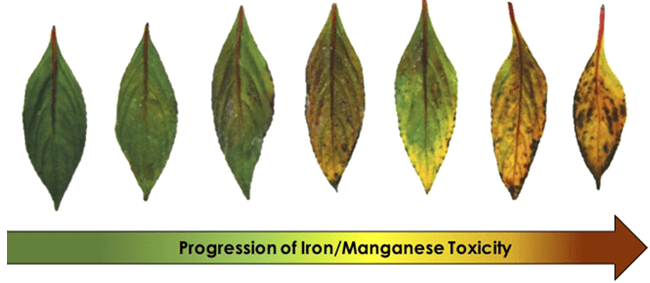
- Deep green or blue green older leaves.
- Some plants display purple or brown tinges on the leaves.
- Veins are a deep blue green.
- Roots and new shoots become stunted.
Add compost to the soil.
A light application of dolomite or a light applications of blood and bone is beneficial where there are no chances of related problems with phosphorous or nitrogen on your plants.
MANGANESE Mn: This is the most likely micronutrient to cause deficiency problems for healthy plant growth in Australia. It is usually a problem in sandy acid soils or soils with a high pH reading.
- It is also very important in breakdown of carbohydrates or sugars to create heat and energy in the night time reactions.
- It is essential for correct functioning of enzymes within the leaves and roots.
- It is essential in the metabolism of nitrogen throughout the plant.
- Is utilized by legumes in working with nitrofixing bacteria.
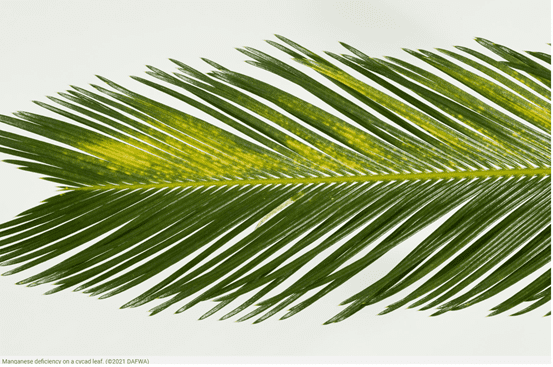
Deficiencies symptoms are: May eventuate from excessive use of calcium or sudden introduction of calcium to the soil.
- Pale dull diffusing of yellow-green mottling between the interveinal areas of the older leaves at first.
- A green band remains around the veins of the leaves.
- It is more prominent on the southern side of trees.
- It is more noticeable after a cold spell once the new growth flush has appeared where nutrients will be transported to the new foliage.
Spray the foliage with liquid worm castings.
Spray the foliage with iron chelate as a quick fix.
Add crusher dusts from black or brown basalts that have visible traces of iron sulphide or fools gold which are good sources of Iron to your compost.
Also ensure the compost mixes contain nettles or thistles to really lift the iron content. Good compost placed on heavy soils will help restore the balance.
Toxicity symptoms are: Poor soil aeration and low pH soils are the main culprits for manganese problems.
- Interveinal blotching is yellow.
- It is more concentrated near the center of the leaf.
- Is worse on older leaves. New shoots will concentrate the boron in the older leaves.
- Brown blotches occur in the middle of the yellow areas.
- The spots are more uniform across the leaf surface compared to boron toxicity.
- Leaf tip or margins become decurved or recurved
- The occurrence of MnO2 crystals may appear on the brown blotches near the base or on the petioles.
- Roots will become stunted.
- Sesencences occurs in older leaves first as toxicity increases.
Add compost to the soil to help in aeration or add course sand to heavy soils.
Add cobalt to your compost as cobalt is an antidote for manganese toxicity.
A light application of dolomite or a light applications of blood and bone is beneficial where there are no chances of related problems with phosphorous or nitrogen on your plants.
MOLYBDENUM Mo: The take up of Manganese is dependant on the soils pH. It is more readily available in acid or low pH soils. This is more apparent in soils where high concentrations of aluminum are present.
- Assists in the reduction of nitrates NO3 to nitrites NO2.
- Is used extensively by Nitrofixing bacteria on nitrogenous plants at the rate of around 10 times that of the host plants.
- It has an essential function in the production of vitamin A carotenoids, vitamin B riboflavin and vitamin C ascorbic acid enzymes.
- It has an important function in splitting water into Hydrogen and Oxygen during photosynthesis.
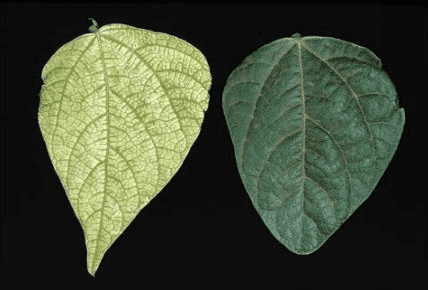
Deficiencies symptoms are: Molybdenum deficiencies look very similar to nitrogen deficiencies. It can be caused by sudden drops in the pH of the soil especially where synthetic fertilizers have been used.
- The leaves older leaves turn yellow.
- The new growth looks dull and lifeless.
- The new growth is slow and stunted.
- May appear as interveinal yellow blotching on lobes of lobed leaf plants.
Spray the foliage with liquid worm castings.
The addition of small quantities of dolomite to rectify pH imbalances are often all that is needed.
In severe cases ammonium molybdate can be added directly to the soil or compost.
Add crusher dusts from black or brown basalts that have visible traces of iron sulphide or fools gold which are good sources of Iron to your compost. Also ensure the compost mixes contain nettles or thistles to really lift the iron content.
Toxicity symptoms are: The symptoms are generally those of Copper deficiencies because it directly affects the availability of copper for use by the plant.
- Pale dull yellowing over the whole lamina.
- The yellowing is over the whole plant uniformly, young leaves and old leaves.
- Leaves curl and roll inwards.
- Leaves may die back at the tips.
Grow of a legume crop over affected land and remove the crop as the plants commence flowering. Remove the plants roots and all if practically possible. Use the plants in compost for use in other parts of the garden or remove from site.
ZINC Zn: Zinc problems are most usually but are caused by the over use of zinc fungicides or zinc depleted soils which are common in sandy soils in the south western corner of Western Australia and south eastern corner of Australia including Victoria and New South Wales.
- Zinc is essential for the transportation of carbohydrates around the plant.
- It regulates the consumption of sugar.
- Energy transfer within the plant.
- Is used in the production of auxin which is produced in the growing tips. Auxin is responsible for the regulation of cell division in plant tissue.
- It is vital in the production of the manufacture of chlorophyll and thus the manufacture of sugars within the plant.
Deficiencies symptoms are: Zinc deficiencies can be caused by sudden rises in the pH of the soil especially where calcium has been used. Trees suffering deficiencies are more likely to be attacked by fungus or bacteria.
- Shoots will appear later than non affected trees.
- The apexes are crinkled while the base is often stunted.
- Trees have bare patches on twigs and branches due to leaf drop and or non formation of leaves or disjunct strips on the twigs.
- Interveinal areas are mottled yellow-green or yellow.
Spray the foliage with liquid worm castings.
Use a foliar spray of double strength seaweed emulsion and kelp pellets around the base of the affected trees.
Add banana peels to your compost. Also ensure the compost mixes contain sea fish waste and sea weed.
Toxicity symptoms are: This is more often a problem that is associated with saline soils, or overuse or excessive use of zinc fungicides over a long period of time. Zinc uptake decreases with a corresponding increase in pH levels or with the addition of phosphorous and in high iron soils.
- Excess zinc will cause iron deficiencies.
- The leaves turn deep green forming“V” patterns along the veins.
- Interveinal chlorosis of pale yellowing to creamy yellow occurs.
- Possible iron deficiency symptoms.
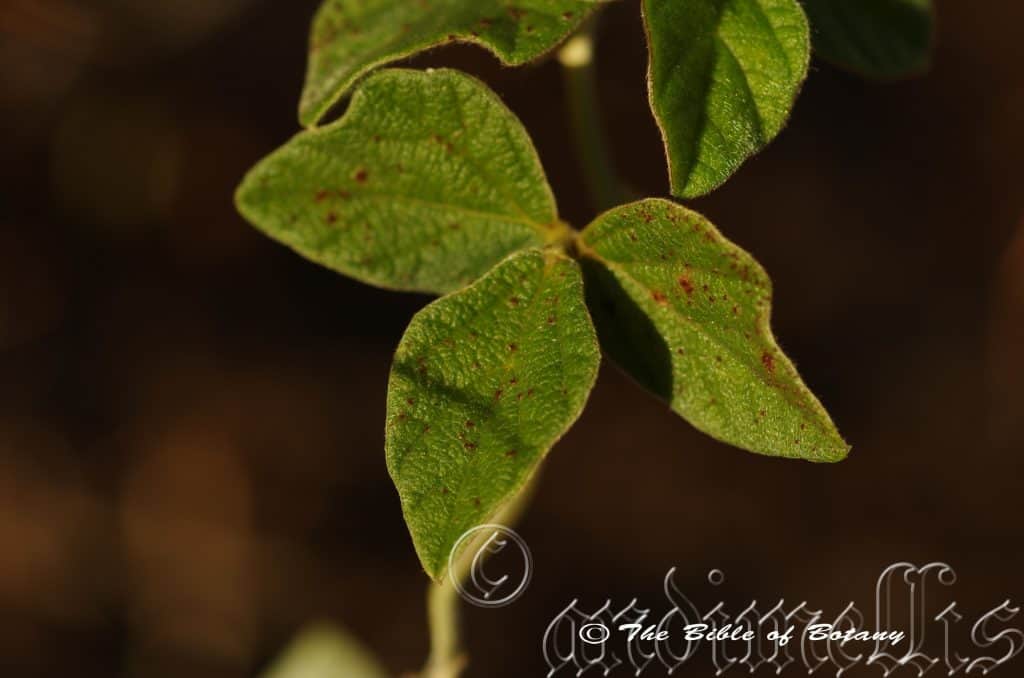
Maintain even water moisture content in the soil.
Blood and bone can be applied if non sensitive calcium and phosphorous plants are involved.
The Trace elements.
SELINIUM Se. High levels of nitrogen in the soil will limit the take up of selenium in plants. High levels of selenium in plants will greatly affect the ability of selenium to function within the plants. The south west corner of Western Australia along 200 kilometer coastal strip from Kalbarn National Park south and east to Cape Arid are deficient in selenium. Selenium deficient soils are known from the north Easter side of Tasmania, Lake Alexandra and the Murray River lower reaches east to north east Gipsland along the coast to within a 150 kilometer strip. Further north deficiencies extend to 400 kilometers inland in several disjunct locations especially on soils derived from granite, metamorphic rocks and sandstone between the Victorian border and Cape Palmerston National Park in Queensland.
- Selenium is essential for the manufacturing of all enzymes within the plant.
Deficiencies symptoms are:
- Lower fruit especially seed production rates.
- Smaller number of leaves.
Selenium deficiencies can be caused by sudden rises in nitrogen in the soil.
Add crusher dusts from black or brown basalts that have visible traces of iron sulphide or fools gold to your compost. These are good sources of selenium as the iron is partially replaced by selenium. Also ensure the compost mixes contain nettles or thistles to help add selenium to the compost as they have a higher uptake of selenium when grown on selenium rich soils
Synthetically produced selenium is not taken up by plants and must first be converted to organic selenium by other organisms in the soil. Soils which rely heavilly on synthetic fertilizers, herbicides, insecticides and fungicides are often depleted in living organisms which may slow the process of conversion down even further.
Toxicity symptoms are: Selenium toxicity levels are unknown in plants.
Cobalt Co: Vegetarians and organically grown foods are noticeably higher in vitamin B12. The uptake of Cobalt where high nitrogenous fertilizers have been used restricts the uptake of cobalt in two ways. First is the affect that cobalt becomes less available to the plant to take up in very high nitrogenous soils and this is greatly exasperated in soils with low levels of cobalt. This again becomes very erratic where synthetic nitrates are added to the soil. Secondly nitrogen is highly mobile in the connective tissue of plants with plants responding quickly with fast terminal growth. Cobalt moves through the connective tissue very slowly so it is left behind in young leaves and shoots as they develop causing the deficiencies.
Cobalt is essential for the manufacturing of vitamin B12 and is at the center of the vitamin B12 molecule.
It is critical as it is required for the fixation of nitrogen in the symbiotic relationship between the rhizobium bacteria and the plant which must supply the cobalt to the bacteria to function efficiently.
It is required in nitrogen fixation.
Deficiencies symptoms are: very similar to nitrogen deficiencies.
- The leaves older leaves turn yellow.
- The new growth looks dull and lifeless.
- The new growth is slow and stunted.
- Premature wilting may occur despite moisture being present in the soil.
Spray the foliage with liquid worm castings.
Add crusher dusts from black or brown basalts which are good sources of cobalt to your compost. Some limestones and dolomites are also high in cobalt so add these to your compost.
Toxicity symptoms are: very similar to manganese toxicity in plants and as such are very difficult to distinguish.
- It is more concentrated near the center of the leaf.
- Interveinal blotching is yellow.
- Is worse on older leaves. New shoots will concentrate the boron in the older leaves.
- Brown blotches occur in the middle of the yellow areas.
- The spots are more uniform across the leaf surface compared to boron toxicity.
- Leaf tip or margins become decurved or recurved
- The occurance of Co crystals may appear on the brown blotches near the base or on the petioles.
- Roots will become stunted.
- Sesencences occurs in older leaves first as toxicity increases.
Add compost to the soil to help in aeration or add course sand to heavy soils if possible.
Add manganese to your compost as manganese is an antidote for cobalt toxicity.
IODINE I:
- Iodine is essential for the manufacturing of Vitamin A.
- It is also important in enzyme production.
Deficiencies symptoms are: There are no obvious symptoms in plants when iodine levels are low. Plant seed production may be less than optimum, but this varies on the families the plants belong to.
Spray the foliage with a double strength solution of seaweed.
Add washed seaweed to your compost which is a good sources of iodine.
Toxicity symptoms: These may vary greatly on the type of plants. Levels in barley that produced greater yields in seed exhibited sever toxicity symptoms in peas and other legume plants.
- It is more concentrated near the center of the leaf.
- Interveinal blotching is yellow.
- Is worse on older leaves. New shoots will concentrate the boron in the older leaves.
- Brown blotches occur in the middle of the yellow areas.
- The spots are more uniform across the leaf surface compared to boron toxicity.
- Leaf tip or margins become decurved or recurved.
- The occurrence of Co crystals may appear on the brown blotches near the base or on the petioles.
- Roots will become stunted.
- Sesencences occurs in older leaves first as toxicity increases.
NICKLE Ni:
Nickel is essential for the efficient use of urease in the plant. Urease is an enzyme which is essential for the plant in converting nonfunctional urea into useable ammonium. Is utilized by legumes in working with nitrofixing bacteria. Is essential for healthy seed germination.
Deficiencies symptoms are:
The leaves older leaves turn yellow.
- The new growth looks dull and lifeless.
- The new growth is slow and stunted.
- Green network of veins over a dull yellow leaf.
- Low levels of nickel in seeds display slow or erratic germination and are less vigorous.
Nickel deficiencies can be caused by sudden rises in the pH of the soil especially where calcium has been used.
Spray the foliage with liquid worm castings.
Add crusher dusts from black or brown basalts that have visible traces of iron sulphide or fools gold which are good sources of nickel to your compost.
Toxicity symptoms are: usually only evident around mining sites where the plants are exposed to high levels of nickel in the soil, air and water.
The emergence of pale and deep coloured green bands of leaves that unfold or wrapped in a sheath. The day time growth is deep green while the night time growth is pale green to almost yellow.
VANADIUM Va:
- Vanadium is essential for the manufacturing of chlorophyll in the leaves.
- It is also very important in most enzymes.
- Energy transfer within the plant.
- Is utilized by legumes in working with nitrofixing bacteria.
Deficiencies symptoms are: There are no visible symptom signs to recognize vanadium deficiency as it accumulates in the roots.
Vanadium deficiencies can be caused by sudden drops in the pH of the soil especially where sulphur or aluminum are present in high levels.
Add crusher dusts from black or brown basalts that have visible traces of iron sulphide or fools gold which are good sources of vanadium to your compost.
Toxicity symptoms are: Some leaf burn may exist in plants that are sensitive to vanadium toxicity.
A light dusting of the soil with gypsum or dolomite will help alleviate toxicities.
Aluminum Al: Aluminum has no deficiency levels as it is not utilized by the plants. Toxicity levels have been known where high levels occur naturally in the soil. It can manifest problems in the uptake and utilization with alkaloid metals. These metals and minerals may cease to function where Aluminum levels are high.
Fluorine F: Fluorine has no deficiency levels as it is not utilized by the plants. Toxicity levels have been known through an accumulation of fluorine in the water system usually where the town water has had fluoride added. It may become a real concern in cities over a long period where this practice occurs.
The nutrient values of various organic fertilizers are as follows. Remember Organic fertilizers create very strong microbiological activity in the soil where as Synthetic fertilizers often create death of microorganisms in the soil:
Kelp from cold water supplies:
- Nitrogen 1.2mm
- Phosphorous 0.8mm
- Potassium 3%
- Calcium 1.4mm
- Sulphur 1.2mm
- Magnesium 0.69mm
- Sodium 1.4mm
- Iron 266ppm
- Manganese 8.9ppm
- Zinc 0.33ppm
- Copper 8.5ppm
- Cobalt 0.14ppm
- Boron 130ppm
- Molybdenum 0.13ppm
- Crude Fiber 54mm
- Ash 26mm
- Protein 10mm
- Alginic Acids 28mm
- Laminarin 1.6mm
- Mannitol 2.9mm
- (Analysis by Fair Dinkum Fertilizers & Kelp Products)
Fish emulsion:
- Phosphorous 0.3mm
- Potassium 0.25mm
- Calcium 0.5mm
- Fats & Oils 3mm
- (Analysis by Fair Dinkum Fertilizers & Kelp Products)
Hoods Blood & Bone:
- Nitrogen 9mm
- Phosphorous 5mm
- Potassium 1mm
- Calcium 10mm
The different States in Australia have different policies for soil and tissue analysis testing and are usually set aside for professional farmers not residential properties however most will offer advice and tell you where to go in a friendly way of course.
The Importance of Soil analysis & Testing for Australian Growers:
Growers should not under estimate how important it is to know their soils. Proper and timely soil analysis and testing will deliver better results in the long term. It is important to note that the information received from soil analysis and testing, particularly as it relates to local conditions across Australia, is highly dependent on how the samples are obtained, the overall agricultural soil testing strategy used, and the procedures employed by the soil testing lab.
The details below outline how a sample should be taken. These details should assist your agronomists or agriculturalist to assist the grower.
Soil Analysis and Soil Testing:
Soil tests should provide you with a complete report on the status of your soil’s mineral and micronutrient makeup. The information contained in this report provides growers and agronomists with valuable guidance on proper fertilizer selection and micronutrient applications.
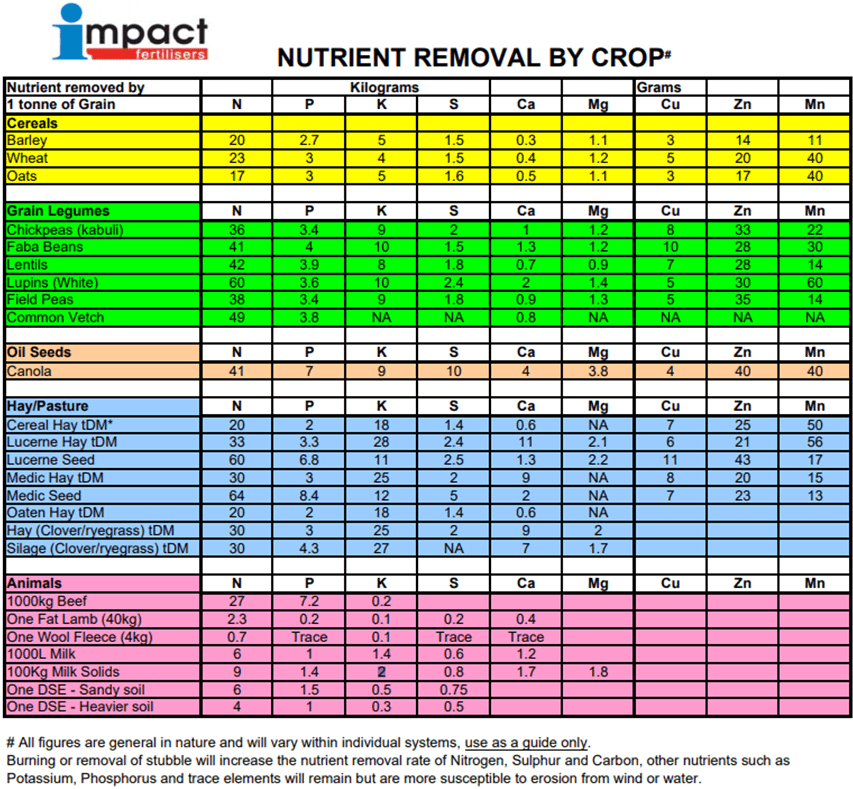
These soil tests include: Total Soil (with PBI) (S7): pH (H2O), pH (CaCl2), EC, S, P, Na, K, Ca, Mg, Al, Cl, Cu, Zn, Mn, Fe, B, NH4-N, NO3-N, mm Organic Matter, colour, texture, Lime requirement, CEC, Ca/Mg ratio, mm Base saturation & PBI.
Soil samples are best taken 4 to 6 weeks prior to planting and not within 12 weeks of fertilizer being added to the soil.
Use a clean hygienically sealed plastic bag. The type of plastic is important as cheap plastics can affect the results. Mark the bags top-soil, Sub-soil field 1, 2 or whatever, clearly so you can identify where the sample came from at a later date.
Take the samples from each different field and treat them as individual fields unless the initial tests prove they are very similar.
Using a hygienically clean stainless steel spoon, take one heaped spoonful from each of 6 locations evenly spaced in the field. Do not take samples near to where water drips, buildings, roads or drains.
Crosses shows a typical 8 formation with blue for a 7 or 13 formation on a rectangular field.
| X | X | X | ||||||||||
| X | X | X | X | |||||||||
| X | X | X | X | |||||||||
| X | X |
Place the samples into a bag one for the top-soil and a separate bag for the sub-soil.
Top-soils should be tested on an annual basis until the soils are corrected and organically stable. This is important to determine the best crops or species to plant and grow. For each soil type in the field take 6 to 10 samples from below the surface at a depth of 30mm to 50mm.
Sub-soils should also be done in initial tests to sample and monitor pH, iron and aluminum. This is important to determine if sub-soil acidity will affect the survival and maximum production of more sensitive species. For each soil type/ paddock, take 6 to 10 subsoil samples from a depth of 300mm to 400mm or the top of the B horizon in duplex soils. Remove the top soil without contaminating the sub soil using hygienically cleaned equipment. 606omm to 75mm hand augers are ideal for this purpose if a stainless steel silage corer is unavailable. Remove the core and take the sample inside the core away from the edges at the depth required. Do not use chemicals to clean the equipment.
Plant Tissue Analysis and Testing:
Crop and pasture analysis helps to quickly identify visible plant issues as well as issues which do not yet have visible symptoms. Accurate assessment of your crop’s and nutritional status helps enable rapid remediation of any nutritional deficiencies.
Standardized plant tissue testing should include: Total Crop (P3): N, S, P, K, Ca, Mg, Cu, Zn, Mn, Fe, B, Na, Mo, Cl, NO3-N.
Basic Pasture grasses weeds Plus (P5): N, S, P, K, Ca, Mg, Cu, Zn, Mn, Fe, B, Na, Mo, Co, Se.
Tissue samples are best taken after the mature leaves have developed. For Hemp this means after 2 to 4 leaves have matured remove the middle mature leaf. Alternatively for on going tests on an annual basis they can be taken closer to the heads prior to flowering. Do not use distorted or leaves that are showing abnormalities unless a high percentage show the abnormality. Take average leaves.
Use a clean hygienically sealed white paper bag. Plastic can affect the results. Mark the bags Field 1, 2 or whatever, clearly so you can identify where the sample came from at a later date.
Take the samples from each different field and treat them as individual fields unless the initial tests prove they are very similar. Keep the crop and the weeds separate.
Green shows a typical formation on a rectangular field.
| X | X | X | ||||||||||
| X | X | X | X | |||||||||
| X | X | X | X | |||||||||
| X | X |
Using clean hands or a hygienic knife remove 1 leaf from10 to 13 locations evenly spaced in each field. Do not take samples near to where water drips, buildings, roads or drains. Select clean dry leaves.
Place the samples into a bag one for each field and one for the crop and one for the weeds.
The method of collecting leaves is similar if a disease, nutrient deficiency or toxicity is suspected however the affected leaves are collected.
Further comments from Members:
“Hi reader, it seems you use The Bible of Botany a lot. That’s great as we have great pleasure in bringing it to you! It’s a little awkward for us to ask, but our first aim is to purchase land approximately 1,600 hectares to link several parcels of N.P. into one at The Pinnacles NSW Australia, but we need your help. We’re not salespeople. We’re amateur botanists who have dedicated over 30 years to saving the environment in a practical way. We depend on donations to reach our goal. If you donate just $5, the price of your coffee this Sunday, We can help to keep the planet alive in a real way and continue to bring you regular updates and features on Australian plants all in one Botanical Bible. Any support is greatly appreciated. Thank you.”
In the spirit of reconciliation we acknowledge the Bundjalung, Gumbaynggirr and Yaegl and all aboriginal nations throughout Australia and their connections to land, sea and community. We pay our respect to their Elders past, present and future for the pleasures we have gained.